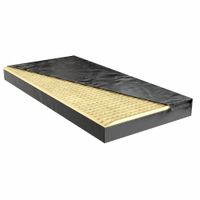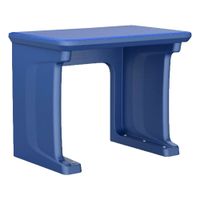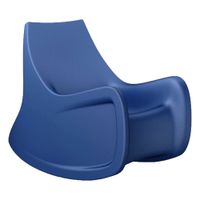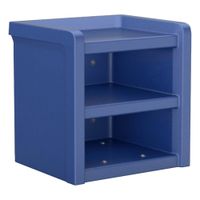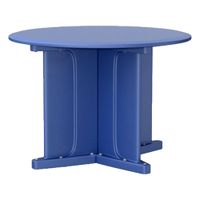Call +(254) 703 030 000 / 751 483 999 / 721 704 777
- Home
- Furnishings Appliances Hospitality
- Furniture
- Institutional Furniture
Frequently Asked Questions
What are the benefits of using institutional furniture in healthcare and correctional facilities?
Institutional furniture in healthcare and correctional facilities offers several benefits:
1. **Durability and Safety**: Designed to withstand heavy use, institutional furniture is made from robust materials like steel and high-grade plastics, ensuring longevity. In correctional facilities, this reduces the risk of damage or misuse as potential weapons, enhancing safety.
2. **Hygiene and Maintenance**: Furniture in healthcare settings is often made from materials that are easy to clean and resistant to bacteria and viruses, crucial for infection control. This ensures a sanitary environment, reducing the spread of diseases.
3. **Comfort and Ergonomics**: Institutional furniture is designed with user comfort in mind, which is essential in healthcare for patient recovery and in correctional facilities for maintaining morale. Ergonomic designs help prevent strain and injury, promoting well-being.
4. **Cost-Effectiveness**: Although the initial investment may be higher, the durability and low maintenance requirements of institutional furniture lead to long-term cost savings. This is particularly beneficial for budget-conscious public institutions.
5. **Security Features**: In correctional facilities, furniture often includes security features such as being bolted to the floor or having rounded edges to prevent harm. This minimizes risks and enhances the safety of both inmates and staff.
6. **Customization and Flexibility**: Institutional furniture can be customized to meet specific needs, such as adjustable beds in hospitals or modular designs in correctional facilities that can be reconfigured as needed.
7. **Compliance and Standards**: Institutional furniture often meets specific regulatory standards for safety and accessibility, ensuring compliance with legal requirements and enhancing the facility's reputation.
8. **Aesthetic and Psychological Impact**: Well-designed furniture can create a more welcoming and less institutional atmosphere, which can positively impact the mental health of patients and inmates, aiding in recovery and rehabilitation.
How does institutional furniture prevent tampering and ligature risks?
Institutional furniture is specifically designed to mitigate tampering and ligature risks, which are critical concerns in environments like hospitals, psychiatric facilities, and correctional institutions. These pieces of furniture incorporate several design features to enhance safety and security:
1. **Tamper-Resistance**: Institutional furniture is constructed with robust materials such as heavy-gauge steel or solid wood, making it difficult to dismantle or damage. Fasteners and joints are often concealed or require specialized tools to access, preventing unauthorized disassembly. Surfaces are typically smooth and seamless, reducing the potential for hiding contraband or creating makeshift weapons.
2. **Ligature-Resistance**: To prevent self-harm or suicide attempts, furniture is designed with minimal points where a ligature could be attached. This includes rounded edges, sloped tops, and the elimination of protrusions or gaps that could be used to secure a rope or cord. Beds, for example, may have integrated frames with no under-bed space to prevent tying off ligatures.
3. **Fixed Installations**: Many pieces are bolted to the floor or walls, preventing them from being moved or used as barricades. This also reduces the risk of furniture being used as a weapon against staff or other individuals.
4. **Durability and Maintenance**: The materials used are not only strong but also easy to clean and maintain, which is crucial in high-use environments. This ensures that the furniture remains in good condition, reducing the need for frequent repairs that could introduce new risks.
5. **Design and Testing**: Institutional furniture is often subject to rigorous testing and standards to ensure it meets safety requirements. Manufacturers work closely with facility managers to tailor designs that address specific environmental risks.
These features collectively contribute to a safer environment by minimizing opportunities for tampering and reducing the risk of self-harm or harm to others.
What materials are commonly used in the construction of institutional furniture?
Institutional furniture, designed for environments such as schools, hospitals, and offices, requires durability, functionality, and ease of maintenance. Common materials used in its construction include:
1. **Wood**: Often used for its aesthetic appeal and strength, hardwoods like oak, maple, and cherry are popular. Plywood and medium-density fiberboard (MDF) are also used for cost-effectiveness and versatility.
2. **Metal**: Steel and aluminum are frequently used for frames and structural components due to their strength and durability. They are often powder-coated or painted to prevent corrosion and enhance appearance.
3. **Plastic**: High-density polyethylene (HDPE) and polypropylene are used for their lightweight, durable, and easy-to-clean properties. They are often molded into chairs, desks, and storage solutions.
4. **Laminate**: Used as a surface material on desks and tables, laminate provides a durable, scratch-resistant, and easy-to-clean finish. It is available in various colors and patterns, allowing for aesthetic flexibility.
5. **Fabric**: Upholstery fabrics, often made from synthetic fibers like polyester or nylon, are used for seating. These materials are chosen for their durability, stain resistance, and ease of cleaning.
6. **Foam**: High-density foam is used in seating for comfort and support. It is often covered with fabric or vinyl for protection and aesthetics.
7. **Glass**: Tempered glass is sometimes used in institutional furniture for tabletops and partitions, offering a modern look while being strong and easy to clean.
8. **Composite Materials**: Engineered materials like fiberglass and carbon fiber are occasionally used for their strength-to-weight ratio and design flexibility.
These materials are selected based on the specific needs of the institution, balancing factors such as cost, durability, maintenance, and aesthetics.
How do institutional beds and mattresses differ from regular ones?
Institutional beds and mattresses are specifically designed to meet the needs of environments such as hospitals, nursing homes, and other healthcare facilities, differing significantly from regular residential beds and mattresses in several ways:
1. **Durability and Materials**: Institutional beds and mattresses are constructed with high-durability materials to withstand frequent use and rigorous cleaning protocols. They often feature antimicrobial and waterproof surfaces to prevent infection and contamination, unlike regular mattresses which prioritize comfort and aesthetics.
2. **Adjustability and Functionality**: Institutional beds often come with adjustable features, such as the ability to raise or lower the head, foot, or entire bed, to accommodate medical needs and enhance patient comfort. Regular beds typically lack these features, focusing instead on static designs.
3. **Safety Features**: Institutional beds are equipped with safety features like side rails, locking wheels, and emergency CPR functions to ensure patient safety and facilitate medical care. Regular beds do not usually include these features, as they are not necessary for home use.
4. **Size and Design**: Institutional beds are often designed to be narrower and more compact to fit into clinical settings and allow for easy maneuverability. They may also include features like built-in scales or monitoring systems. Regular beds come in standard sizes like twin, queen, or king, focusing on personal comfort and style.
5. **Compliance and Standards**: Institutional beds and mattresses must comply with specific healthcare regulations and standards, such as those set by the FDA or other health authorities, to ensure they meet safety and hygiene requirements. Regular beds are subject to general consumer safety standards but do not have to meet the stringent criteria required for medical use.
These differences ensure that institutional beds and mattresses are suitable for healthcare settings, prioritizing patient care, safety, and hygiene over the comfort and design considerations typical of regular beds.
What features should be considered when selecting institutional seating?
When selecting institutional seating, consider the following features:
1. **Durability**: Choose materials that withstand heavy use and are resistant to wear and tear, such as metal or high-quality plastic.
2. **Comfort**: Ensure ergonomic design with adequate cushioning and support to promote comfort during prolonged use.
3. **Flexibility**: Opt for modular or stackable designs that allow for easy reconfiguration and storage.
4. **Safety**: Look for seating with rounded edges and non-slip surfaces to prevent accidents.
5. **Maintenance**: Select materials that are easy to clean and maintain, such as stain-resistant fabrics or wipeable surfaces.
6. **Aesthetics**: Consider the design and color scheme to ensure it complements the institution's environment and branding.
7. **Functionality**: Ensure the seating meets the specific needs of the institution, such as foldable options for multipurpose spaces or armrests for added support.
8. **Space Efficiency**: Choose designs that maximize seating capacity without overcrowding, especially in limited spaces.
9. **Cost**: Balance quality with budget constraints, considering long-term value over initial expense.
10. **Accessibility**: Ensure compliance with ADA standards, providing options for individuals with disabilities.
11. **Noise Reduction**: Consider seating with noise-dampening features to maintain a quiet environment.
12. **Warranty and Support**: Check for manufacturer warranties and customer support for repairs or replacements.
13. **Sustainability**: Opt for eco-friendly materials and manufacturing processes to support environmental responsibility.
14. **Customization**: Look for options that allow customization to meet specific institutional needs or preferences.
15. **Brand Reputation**: Choose reputable brands known for quality and reliability in institutional settings.
How can institutional shelving units and lockers enhance security?
Institutional shelving units and lockers enhance security in several ways. Firstly, they provide controlled access to stored items. Lockers with secure locking mechanisms, such as key locks, combination locks, or electronic access systems, ensure that only authorized individuals can access the contents. This reduces the risk of theft or unauthorized use of sensitive materials.
Secondly, these units offer organized storage, which helps in maintaining an inventory of items. By keeping items systematically arranged, it becomes easier to notice if something is missing or tampered with, thereby enhancing accountability and reducing the likelihood of internal theft.
Thirdly, institutional shelving and lockers can be designed with durable materials that resist tampering and forced entry. Heavy-duty steel construction, reinforced doors, and tamper-proof hinges add an extra layer of physical security, making it difficult for intruders to break in.
Additionally, lockers and shelving units can be integrated with security systems such as surveillance cameras and alarm systems. This integration allows for real-time monitoring and alerts in case of unauthorized access attempts, further deterring potential security breaches.
Moreover, these storage solutions can be customized to meet specific security needs. For instance, lockers can be equipped with ventilation to safely store hazardous materials, or they can be fire-resistant to protect valuable documents and equipment from fire damage.
Finally, institutional shelving and lockers contribute to a secure environment by promoting a culture of responsibility and trust. When individuals know that their belongings are stored securely, it fosters a sense of security and encourages adherence to security protocols.
In summary, institutional shelving units and lockers enhance security by providing controlled access, organized storage, durable construction, integration with security systems, and customization options, all of which contribute to a safer and more secure environment.
What are the installation requirements for institutional bolt-down kits?
Institutional bolt-down kits are used to secure furniture and equipment in environments like schools, hospitals, and correctional facilities. The installation requirements typically include:
1. **Assessment of Surface**: Ensure the surface (floor or wall) is suitable for anchoring. Concrete, wood, and metal surfaces are common, but each requires specific anchors.
2. **Tools Required**: Common tools include a drill, appropriate drill bits (masonry bits for concrete), a wrench or socket set, and a level.
3. **Anchor Selection**: Choose anchors based on the surface material. Expansion anchors are suitable for concrete, while toggle bolts may be used for hollow walls.
4. **Load Capacity**: Verify that the anchors and bolts can support the weight and stress of the item being secured.
5. **Compliance with Regulations**: Ensure installation meets local building codes and safety regulations, especially in public institutions.
6. **Positioning**: Mark the exact position for installation, ensuring alignment and spacing are correct to prevent stress on the anchors.
7. **Drilling**: Drill holes to the specified depth and diameter for the chosen anchors, ensuring they are clean and free of debris.
8. **Anchor Installation**: Insert anchors into the drilled holes, ensuring they are flush with the surface.
9. **Securing the Item**: Position the item over the anchors, insert bolts through the item into the anchors, and tighten securely.
10. **Inspection and Testing**: After installation, inspect to ensure stability and test to confirm the item is securely fastened.
11. **Documentation**: Maintain records of installation for future reference and compliance verification.
12. **Periodic Maintenance**: Schedule regular checks to ensure the integrity of the installation over time.
